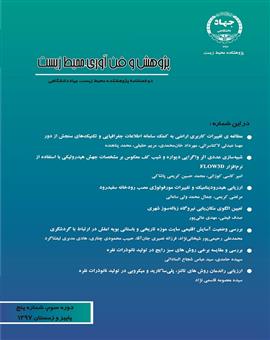بررسی و مقایسه برخی روشهای سبز رایج در تولید نانوذرات نقره
محورهای موضوعی : تکنولوژی آب و فاضلابسپیده حامدی 1 , سید عباس شجاع الساداتی 2
1 - تهران
2 - دانشگاه تربیت مدرس
کلید واژه: روشهای سبز تولیدذرات نقره آنزیم نیترات رداکتاز ,
چکیده مقاله :
امروزه نیاز فزایندهای به توسعه روشهای مقرون بهصرفه، با بازدهی بالا، غیرسمی و زیست سازگار برای ساخت نانوذرات فلزی وجود دارد. از اینرو استفاده از روش های سبز جهت تولید نانوذرات مرسوم شده است. از میان نانوذرات فلزی، نانوذره نقره بهدلیل دارا بودن خواص درمانی از اهمیت ویژه ای برخوردار است. بنابراین در این مقاله روشهای سبز پلیساکارید، تالنز و زیستی مورد بررسی و مقایسه قرار میگیرد. در روش پلیساکارید و تالنز از مواد بی خطر و غیرسمی نشاسته و بتا دیگلوکز (بهعنوان پایدارکننده و احیاگر) و در روش زیستی از توده سلولی و صافیده قارچ فوزاریوم اکسیسپوروم استفاده شد. تصاویر SEM و طیف جذب UV-vis نانو ذرات ساخت شده از سه روش بالا، نشان داد که روش پلیساکارید به تولید نانوذرات با اندازه کوچکتر و بهرهدهی بالاتر منجر میشود. همچنین بهدلیل نقش مهم آنزیم نیترات رداکتاز وابسته به NADH در تولید خارج سلولی نانوذرات نقره، سنجش فعالیت این آنزیم در مدت رشد قارچ فوزاریوم با روش رنگسنجی هارلی در دستور کار قرار گرفت. نتایج نشان داد، تغییرات وزن خشک سلولی بر فعالیت آنزیمی تاثیر دارد.
Nowadays, there is an increasing need to develop high-yield, low cost, nontoxic, and eco-friendly procedures for synthesis of metallic nanoparticles. Therefore, the green synthesis methods become customary for synthesis of nanoparticles. Among metallic nanoparticles, nanosilver has developed because of its therapeutic properties. So in this paper, polysaccharide, tollens and biological green methods were investigated. In polysaccharide and tollens methods, starch and β-D glucose were used as a satabilizer and reducer respectively. In biological method biomass and cell filtrate of the Fusarium oxysporum fungus were used for the synthesis of nanoparticles. SEM images and UV-visible absorbtion spectra of these procedures showed that the polysaccharide method produced smaller silver nanoparticles wih high productivity. The changes of NADH-dependant nitrate reductase enzyme activity was evaluated in growh duration by colorometric Harely method due to importance of this enzyme in extracellular synthesis of silver nanoparticles. Results showed that the changes of dry cell mass impact on the enzyme activity.
1. Prasad, K., Anal, K. J., (2010). Biosynthesis of CdS nanoparticles: An improved green and rapid procedure, Journal of Colloid and Interface Science. 342: 68-72.
2. Gajbhiye, M., Kesharwani, J., Ingle, A., Gade, A., Rai, M., (2009). Fungus-mediated synthesis of silver nanoparticles and their activity against pathogenic fungi in combination with fluconazole. nanomedicine. 5: 382-386.
3. Khosravi, A., Shojaosadati, S. A., (2009). Evaluation of silver nanoparticles produced by fungus Fusarium oxysporum. International Journal of Nanotechnology.6: 973-983.
4. Shirinyan, A., M. Wautelet., (2006). On phase change in nanosystems. Materials science and engineering. 26: 735-738.
5. Saifudin, N., Wong, C.W., Nur yasumira, A. A., (2009). Rapid Biosynthesis of Silver Nanoparticles Using Culture Supernatant of Bacteria with Microwave Irradiation, E-Journal of Chemistry. 6: 61-70.
6. Ahmad, A., Mukherjee, P., Senapati, S., (2003). Extracellular biosynthesis of silver nanoparticles using the fungus Fusarium oxysporum. Clloids and surfaces. 28: 313-318.


